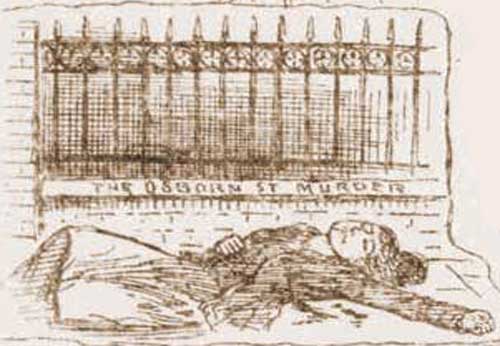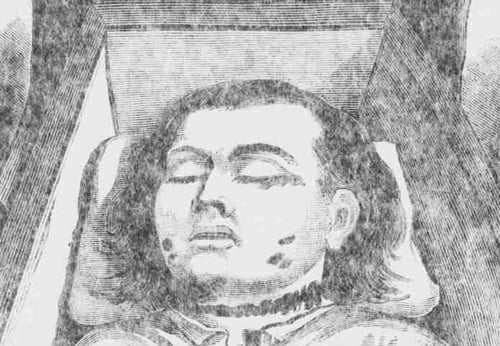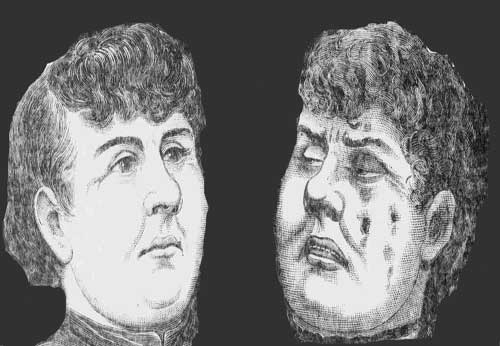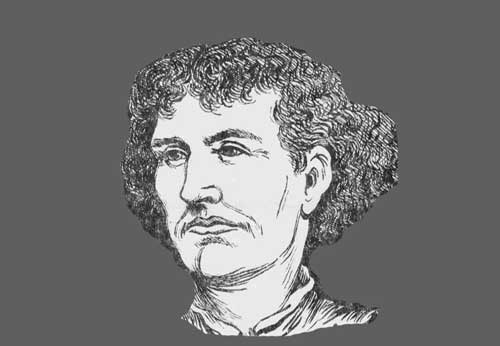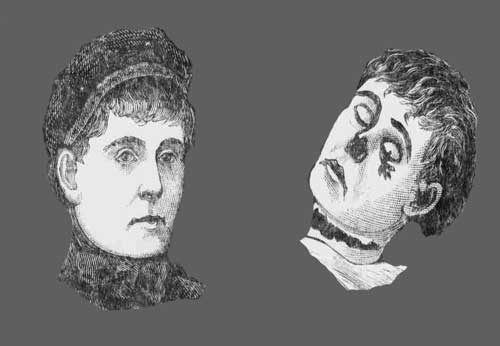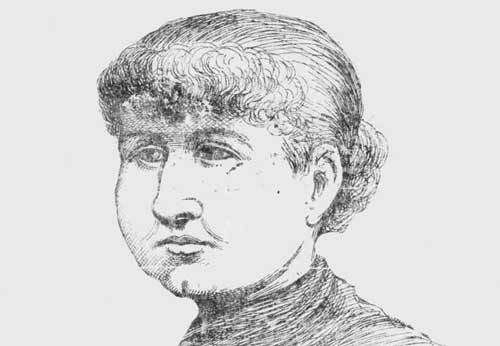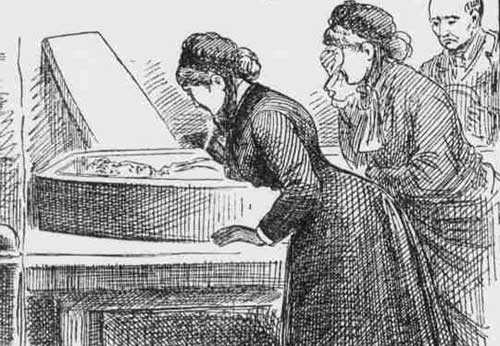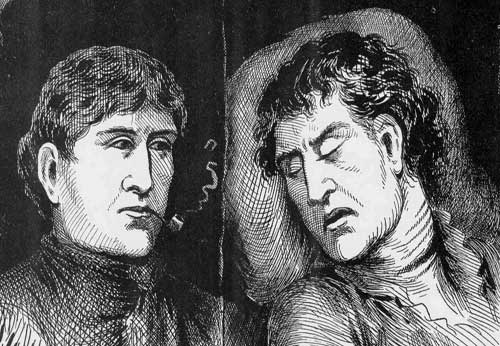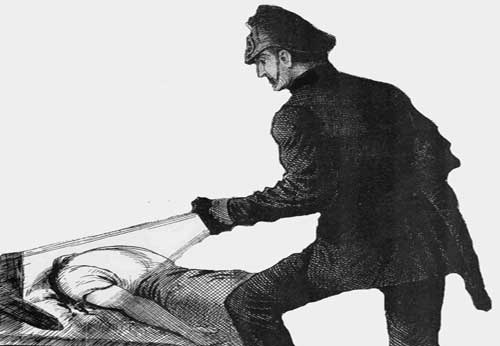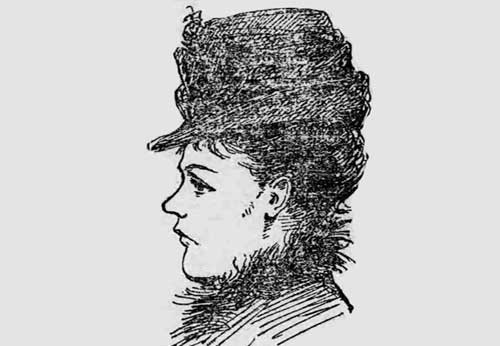- The body of Martha Tabram was found on a first floor landing of George Yard Buildings just before 5am on 7th August, 1888.
- She had been subjected to a ferocious attack, and 39 stab wounds had been inflicted on the body between her throat and lower abdomen.
- There is a great deal of debate over whether or not she was the first victim of Jack the Ripper.
- Site Author and Publisher Richard Jones
- Richard Jones
MARTHA TABRAM - MURDERED AUGUST 7TH 1888
THE LIFE AND DEATH OF MARTHA TABRAM
THE GEORGE YARD VICTIM
Martha Tabram - or Martha Turner as she was known at the time of her murder - was born Martha White on the 10th of May, 1849, in the Southwark district of south London. She was the youngest of five children of Charles and Elizabeth White, and the family home was at 17 Marshall Street, in Southwark.
In May, 1865, when Martha had just turned sixteen, her father abandoned the family, and went to live in Pitt Street, Southwark, where he would die on the night of November 15th of that year.
HER DOOMED MARRIAGE TO HENRY SAMUAL TABRAM
In her late teens, Martha met and began living with, Henry Samuel Tabram, a foreman furniture packer, and on Christmas Day, 1869, the couple were married at Trinity Church, Newington.
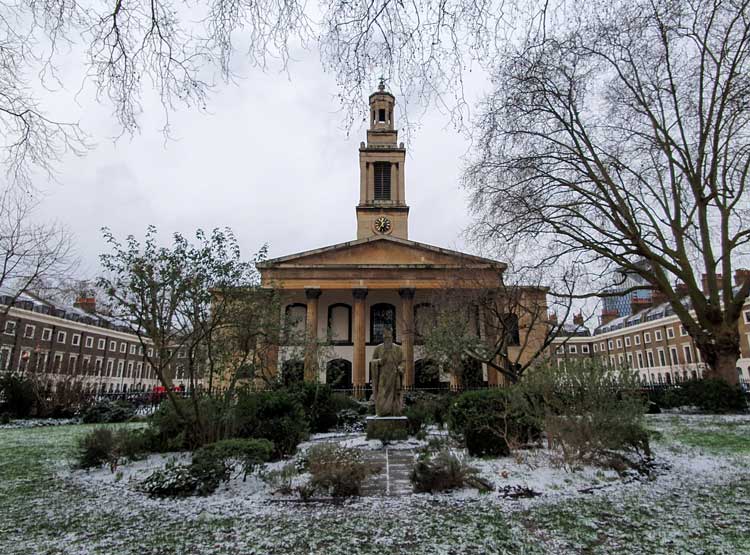
Trinity Church, Newington, Where Martha Tabram Was Married.
The newlyweds moved into a house at 20, Marshall Street, close to what had been Martha's childhood home, and the couple would have two children together; Frederick, born in 1871, and Charles, born in 1872.
However, over the next few years, Martha began drinking heavily, and her intemperance became a bone of contention in the family home, so much so that, in 1875, Henry left her on account of it.
HE PAID A WEEKLY ALLOWANCE
Subsequently, Martha took out a court summons against Henry for desertion, and he agreed to pay her a weekly maintenance allowance of twelve shillings. He paid the sum regularly; until, that is, he heard that she was living as a prostitute, whereupon reduced the allowance to half-a-crown.
Then, in 1879, he learnt that she was living with a man by the name of William Turner, and he stopped the payments to her altogether.
Thereafter, he only saw her very occasionally, and, when he did encounter her in the street, she would always accost him for money.
The last time he saw her was approximately 18 months before her death, when he met her on Whitechapel Road.
LIVING WITH WILLIAM TURNER
Having taken up with William Turner, Martha would live with him, on and off, until three weeks before her death.
Over the next few years, the couple gravitated to the East End of London, where, like many in the district, they lived a transient existence, alternating between rented rooms and the common lodging houses that were so prevalent in the area.
Although Turner was a carpenter, he found it difficult to obtain employment in that trade, and so the couple earned a living hawking cheap trinkets, menthol cones and needles and pins on the streets of London, Martha's preferred pitch at which to hawk her wares being Cheapside, in the City of London.
As far as many who knew the couple were concerned, they were man and wife, and she was universally known in the district as Martha Turner.
MARTHA'S DRINKING STILL A PROBLEM
Her drinking also caused problems in this relationship.
William Turner would later recall that:-
Since she has been living with me, her character for sobriety was not good. If I gave her any money, she generally spent it in drink. In fact, it was always drink...
I am a man of sober habits as a rule, and we usually agreed well enough together as long as she remained sober, but when she got the worse for drink, I left her. There was no quarrel then, I simply left her."
SHE RESORTED TO PROSTITUTION
It appears, however, that Martha would often supplemented her income with prostitution.
At the inquest into her death, Turner would recall how:-
She was in the habit of staying out late at night. I couldn't say for certain what time she usually came home. When I was with her it was usually eleven o'clock, except on Saturday night when it was usually twelve. The average, I should think, would be about elven o'clock. When she took to drink, however, I generally left her to her own resources and I can't answer for her conduct then."
SHE LODGED IN STAR PLACE
In March, 1888, Martha rented a room from Mary Bousfield, at 4, Star Place, Star Street, off Commercial Road, for which she paid a weekly rent of two shillings. William Turner stopped by to share the room from time to time, presumably on those occasions when he and Martha had not separated on account of her drinking.
Mrs. Bousfield also noticed Martha's fondness for drink, although, when she testified at the inquest into Martha's death, she was at pains to stress that Martha was never a problem drinker:-
I have formed no opinion as to whether she was of intemperate habits. She would rather have a glass of ale than a cup of tea, however.
She wasn't a woman who got habitually drunk, and I, myself, have never seen her intoxicated."
Three weeks before her death, Martha had fallen behind with her rent, and she suddenly left without giving notice and without paying the arrears.
Mary Bousfield would tell the inquest that Martha had returned one night, unbeknown to her, and, having forced a window, she had spent the night in the room. Before she left the next morning, she had left her key behind.
THEY ARRIVE IN SPITALFIELDS
William Turner went to reside in the Workingman's Home on Commercial Street, whilst Martha moved into a common lodging house at 19, George Street, Spitalfields.
Turner last saw Martha alive on the afternoon of Saturday, 4th August, 1888, when he met her by the Aldgate Pump, which still stands at the junction of Leadenhall Street and Aldgate High Street.
She told him that she had got no money, so he gave her one shilling and sixpence to enable her to purchase some stock "with which to earn a few ha'pence."
He later estimated that their encounter lasted around twenty minutes.
Having handed over the money, the couple parted, and he would never see her alive again.
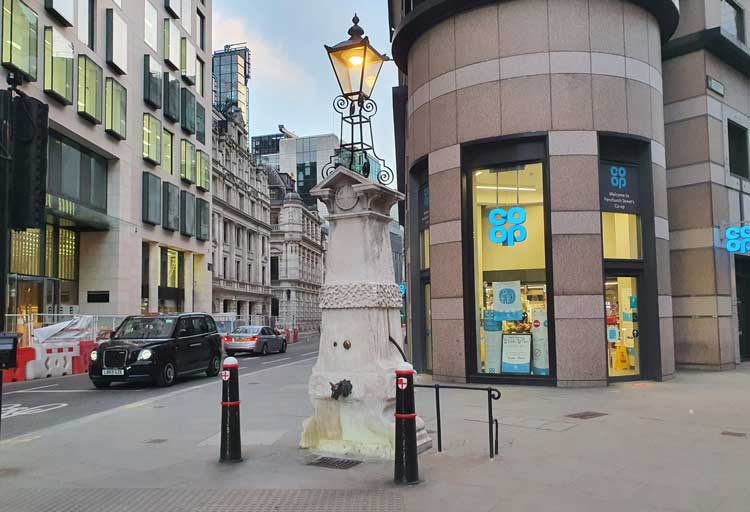
The Aldgate Pump, Where William Turner Last Saw Martha Alive.
A MISERABLE AND WET BANK HOLIDAY MONDAY
The summer of 1888 was a cold and a wet one, and the newspapers were constantly bemoaning the amount of rainfall and the lack of sunshine. There were times when the streets of London became veritable quagmires, and most people couldn't remember a worse summer.
The bank holiday Monday of the 6th of August saw no let up in the miserable conditions, and, although the rain held off till the evening, the dark sky and prevailing coldness rendered the usual bank holiday outdoor pursuits unappealing to say the least.
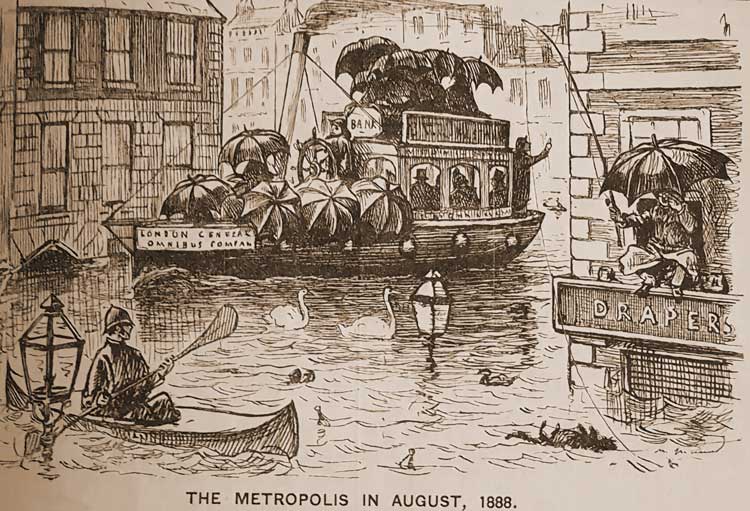
MARTHA TABRAM'S LAST NIGHT
It is not known how Martha Tabram spent what would be the last day of her life.
However, at some stage on the Monday evening, she met with fellow prostitute Mary Anne Connelly, also known in the district as "Pearly Poll" - who was described by several newspapers as "a tall, masculine-looking woman - and the two went drinking together.
Although Connelly stated that the two were friends, none of Martha's close associates appear to have known anything about "Pearly Poll". Connelly would also state later that she knew the victim as "Emma", not as Martha.
Connelly would give conflicting accounts of their movements on that night, and it is, therefore, difficult to establish an exact timeline of how the evening unfolded.
She told the police that they met in a pub at 11 p.m. and drank in that pub until 11.45. However, she told the inquest into Martha Tabram's death that they had gone drinking in several pubs around the area, beginning their spree at 10pm on the Monday night.
Of course, it is more than possible that Connelly's memory of the evening may have been addled by the amount of drink she had consumed, and recalling the exact sequence of the alcohol-fuelled evening could have proved difficult for her.
MARTHA SEEN BY ANN MORRIS
At 11 p.m., Martha was seen entering the White Swan Pub on Whitechapel High Street by her sister-in-law, Ann Morris, and, according to Ann's inquest testimony, Martha was on her own.
It is possible, therefore, that Martha met Connelly in the White Swan and they either remained there, or they set off from there to drink at various other pubs in the vicinity.
THEY MET TWO SOLDIERS
According to Connelly, they met with two soldiers - a corporal and a private - and were more than happy for the men to buy their drinks for them.
At around midnight, the four left the pub and headed off along Whitechapel High Street, where they split into couples at the entrance to George Yard.
Connelly and her soldier made their way to the next alleyway along, Angel Alley - a dark and sinister little passage that still exists, and which still possesses an exceedingly menacing ambience.
GEORGE YARD
Martha Tabram went with her soldier into George Yard - an equally dark and ominous thoroughfare which also still exists, albeit it is now called Gunthorpe Street.
She would have passed the pub to the left of its entrance, the White Hart, which was built in the late 18th century.
SIR GEORGE'S HOME
A little way past the White Hart, on the left side of George Yard, there still stands a sturdy building, which is now divided into flats, and which has the year of its construction, 1886, emblazoned above its upper level.
In 1888, this was Sir George's Home For Respectable Girls, part of the George Yard Mission that had been established here in 1856 by Provisions merchant turned evangelist George Holland.
On the 27th of September, 1888, the Daily News published the following article that illustrates the impact of the murders on the girls of the neighbourhood:-
Mr. George Holland, whose remarkable work has been going on for so very many years in premises occupying an obscure position in George Yard, Whitechapel, says that the sensation has affected his institution very greatly.
He has some hundreds of young women connected with his place, and many of them have been afraid to stir out after dark.
He is under some anxiety, too, lest ladies who have been wont to come down there on winter evenings to teach and entertain his young people, should be deterred by this latest addition to the evil reputation of Whitechapel."
A DANGEROUS STREET
According to the East London Advertiser, George Yard was:- "...one of the most dangerous streets in the locality..."
But, for a seasoned street walker like Martha Tabram, it offered a reasonable amount of privacy in which to do business.
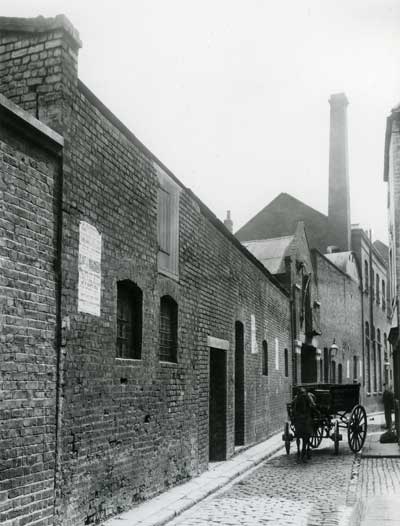
George Yard, 1890
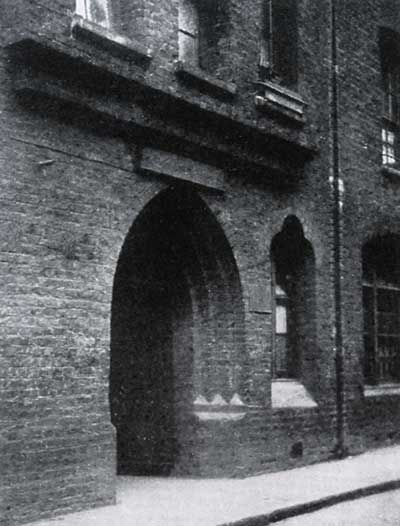
George Yard Buildings
GEORGE YARD BUILDINGS
Towards the top of George Yard, on the left, there stood a block of apartments, known as George Yard Buildings.
The residences here were occupied by tenants whom the East London Observer described, somewhat unflatteringly, as, "people of the poorest description."
When its staircase lights had been extinguished at 11 p.m.. the building's landings were cast into an impenetrable darkness that made them ideal for use by prostitutes and their clients.
Martha would, no doubt, have been aware of this tucked away spot, and it was for one of the building's dark and secluded landings that she probably headed in the company of the soldier.
Of course, it is now impossible to establish whether the soldier was also her killer, or whether a later client carried out the foul deed.
THE MAHONEYS OF GEORGE YARD BUILDINGS
At 1.40 a.m. on the 7th of August, 1888, Joseph and Elizabeth Mahoney, who lived at 37, George Yard Buildings, returned home, having spent the bank holiday Monday with friends.
Almost immediately, Elizabeth headed out again and went to purchase supper from a chandler's shop in nearby Thrawl Street.
She returned with their meal five or so minutes later.
Although she passed the spot where Martha's body would later be found, she saw nothing, although she did concede that the body could have been lying in the darkness on the landing without her noticing it.
THE WAITING SOLDIER
At around 2 a.m., Police Constable Thomas Barret was walking his beat along Wentworth Street.
As he passed the entrance into George Yard, he noticed a soldier loitering there. Barrett remarked to the man that it was quite time that he was in barracks, and the soldier replied that he was waiting for a comrade who had accompanied a woman to one of the buildings close at hand.
Barret appears to have accepted this without question, and had continued on his beat.
ALFRED CROW ARRIVES HOME
At 3.30 a.m., 21-year-old Alfred George Crow, a cabdriver, returned to his home in George Yard Buildings.
As he was going up the stairs, he noticed somebody lying on the floor of the first-floor landing, but, because he often found people sleeping on the landings, he paid so little heed to the prone form that he was unable to say whether it was a man or a woman, or whether the person was alive or dead.
FINDING THE BODY OF MARTHA TABRAM
At around 4.45 a.m., John Saunders Reeves, a casual waterside labourer, headed out of his apartment on the top floor and came down the stairs.
He too noticed the prone form, but as it was now getting light, he was able to see that it was a woman who was lying on her back in a pool of blood.
He hurried off to find a policeman and returned with Constable Barrett, whom he had encountered patrolling in the vicinity of George Yard.
Barrett sent Reeves to fetch local medic Dr. Timothy Killeen, who having carried out an examination of the woman, pronounced life extinct and gave it as his opinion that she had been brutally murdered.
DR. KILLEEN'S OPINION
The attack on Martha Tabram had been a frenzied one.
Thirty-nine stab wounds pepper-potted her body from her throat to her lower abdomen. Dr Killeen later told the inquest that the killer had used two different blades, the majority of the wounds having been inflicted with an ordinary pocket knife, whilst a deep wound to her breast had been dealt by, "...some long, strong instrument…[which could have been]… a sword bayonet or dagger..."
Significantly, he was also of the belief that sexual intercourse had not recently occurred, thus ruling out rape as a motive for the murder.
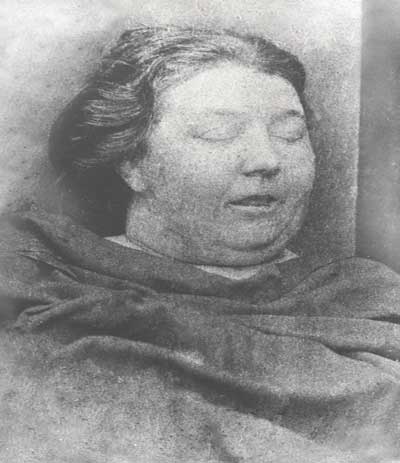
Martha Tabram, Mortuary Photo
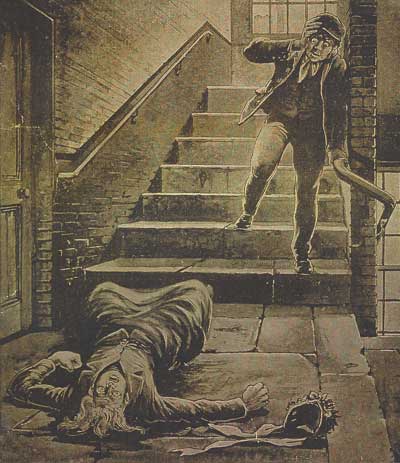
Finding The Body of Martha Tabram
AN UNKNOWN WOMAN
It wasn't long before the victim had been removed from the scene of the crime and had been taken to the nearby mortuary, where the police were then faced with the task of identifying her.
She was, so the police quickly established, unknown to any of the tenants of George Yard Buildings.
The police, therefore, released a description of the unknown woman to the newspapers:-
The body, which was that of a woman, apparently between 35 and 40 years of age, about 5ft. 3in. in height, complexion and hair dark, wore a dark green skirt, a brown petticoat, a long black jacket, and black bonnet.
The woman is unknown to any of the occupants of the tenements on the landing on which the deceased was found, and no disturbance of any kind was heard daring the night
The circumstances of the tragedy are, therefore, mysterious, and the body, which up the time writing had not been identified, has been removed to Whitechapel Mortuary, and Inspector Elliston, of the Commercial Street Police Station, has placed the case in the hands of Inspector Reid, of the Criminal Investigation Department, and that officer is now instituting inquiries."
Source:- The Sheffield Daily Telegraph Wednesday, 8th August, 1888.
THE BODY PHOTOGRAPHED
The body was also photographed at the mortuary, and copies of the photograph were then handed out to detectives and police constables who began showing them to people in the district in the hope that somebody would be able to identify the victim.
Several people claimed to recognise the woman, although they each gave her different names - Mrs. Withers, Mary Bryan and Martha Turner.
IDENTIFYING THE SOLDIER
An important line of enquiry for the police was trying to ascertain the identity of the soldier whom Constable Barrett had encountered at the Wentworth Street entrance into George Yard in the early hours of the morning of the murder
To that end, on the 7th August, 1888, Inspector Edmund Reid, who had charge of the case, escorted Barrett to the Tower of London, where a large military contingent was based, and several soldiers were brought before him. he was, however, unable to identify any of them as being the man he had questioned.
They returned to the Tower the next day, 8th August, and those guards who had been on leave on the night of the Bank Holiday Monday were paraded before him.
This time he picked out two men, who were subsequently taken to the orderly room. Here Barret stated that he had been wrong about the first man, who was then allowed to leave.
The remaining man, whose name was John Leary, was able to give a full account of his movements on the night of the murder, and on his account being corroborated by another soldier, John Law, he was dropped as a suspect.
THE INQUEST OPENS
The confusion over her identity was such that, when the inquest into the woman's death was opened at the Working Lads Institute on Whitechapel Road, on Thursday the 9th of August, 1888, although the victim was believed to be Martha Turner, there was no actual certainty that that was, in fact, the case.
The East London Observer summed up the confusion in its report on the inquest in its edition of Saturday 11th August, 1888:-
The identification, however, of all three was more or less doubted, the greatest credence being attached to a woman who appeared early in the Library with a baby in her arms. She wore a blue dress with a black hat, and a white checked blue handkerchief round her neck.
She had been taken by Banks, the coroner's officer, to view the body at the mortuary, and was positive in asserting that she recognised it as that of a woman of her acquaintance named Martha Turner, a married woman.
But although the inquest was ostensibly carried out upon the body of "Martha Turner," the proofs of the identity were so vague that the deputy-coroner, towards the end of the inquest, expressed the opinion that it was scarcely worth while calling the woman who professed to identify the deceased, as a witness - at all events, not until further proof had been forthcoming of the accuracy of the identification."
Source:- The East London Observer Saturday 11th August, 1888.
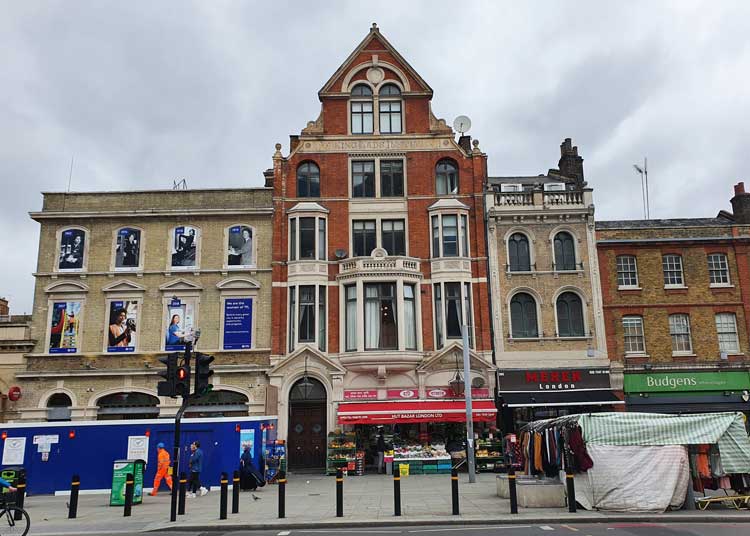
The Former Working Lads Institute, 283, Whitechapel Road.
THE INQUEST ADJOURNED
Of course, since there was doubt over the victim's actual identity, there was little point continuing with the inquiry into her death until it could be ascertained beyond doubt whose death the inquest was being held over.
Having taken evidence from Elizabeth Mahoney, Alfred George Crow, John Saunders Reeves and Dr. Killeen; the deputy-coroner - with what the East London Observer described as "unusual animation" - concluded that:-
...it is one of the most terrible cases that anyone can possibly imagine. The man must have been a perfect savage to have attacked the woman in that way."
So saying, he adjourned the inquest for two weeks in order to allow time for a definite identification to be made and to give the police time to trace, if possible, the perpetrator of the crime.
PEARLY POLL APPEARS
On the 9th August, 1888, Mary Ann Connelly turned up at Commercial Street Police Station, and informed the police of hers and the victim's - whom she said she knew as "Emma" - drinking spree in the company of the two soldiers on the night of the Bank Holiday Monday.
The police placed great faith in what Connelly had to say and asked her to attend an identity parade at the Tower of London the next day. However, she failed to turn up, and the police had to track her down, finally taking her to the Tower on Monday the 13th of August.
Lloyd's List published details of the outcome of this latest parade in its edition of Tuesday, 14th August, 1888:-
Two soldiers were suspected of being concerned in the affair, but yesterday a woman bearing the nickname of "Pearly Poll," who was in the company of the murdered woman, was taken to the Tower by a police-inspector and confronted with every non-commissioned officer and soldier who had leave of absence at the time of the murder, and she failed to recognise any of them. The affair is therefore as great a mystery as ever."
Source:- Lloyd's List Tuesday, 14th August, 1888.
The East London Observer, on Saturday 18th August, 1888, gave a more detailed account of Connelly's performance at the Tower:-
Inspector Reid, accompanied by "Pearly Poll," proceeded to the Tower on Monday afternoon, where she was confronted with every non-commissioned officer and private who was on leave of absence at the time of the outrage.
They were paraded at the back of the Tower, unseen by the public - of whom on Monday there was a large number frequenting the historic structure - and "Pearly Poll" was asked. "Can you see either of the men you saw with the woman now dead?"
"Pearly Poll," in no way embarrassed, placed her arms akimbo, glanced at the men with the air of an inspecting officer, and shook her head.
This indication of a negative was not sufficient.
"Can you identify anyone?", she was asked.
"Pearly Poll" exclaimed, with a good deal of feminine emphasis, "he ain't here."
The woman was very decided on this point, and the men were then dismissed, while the two men upon whom a feint shadow of suspicion had rested were considerably relieved at their innocence being declared..."
Source:- The East London Observer Saturday, 18th August, 1888.
AN IMPORTANT FACT REMEMBERED?
At this point, Connelly remembered that the soldiers had white bands around their caps, which meant that they belonged to the Coldstream Guards.
Inspector Reid, therefore, organised another identity parade, this time at the Wellington Barracks.
The Westminster And Pimlico News reported on what took place in its edition of Saturday, 18th August, 1888.
At noon on Wednesday there was a parade of Coldstream and Grenadier Guards at the Wellington Barracks, Pimlico.
It seems that, soon after eleven o'clock, two police officers - Inspector Reid and Detective-sergeant Caunter - arrived with Mary Ann Connelly (otherwise "Pearly Poll") and requested permission to make certain inquiries in regard to the murder of Martha Turner, at Whitechapel on the night of the Bank Holiday.
The "assembly" call was at once sounded, and the men were drawn up in quarter-column, after which they filed through a passage, where Inspector Reid, Sergeant Caunter, and another police officer were stationed with "Pearly Poll."
The woman was asked to scrutinise the faces of the soldiers as they passed, for the purpose of seeing if she could pick out either of the men who were with her and the deceased on the night on which the murder was committed.
After a small number had filed past, "Pearly Poll" picked out a man wearing stripes, and taken by her to be a corporal, as the one who went away with the deceased woman.
"That's him," exclaimed she; "I'm positive."
The suspect was temporarily detained, and the filing by of the others continued.
When a few more had passed, the woman, scanning the features of every one intently, pointed to a private as being the second man. She positively declared that he accompanied her to a house in the district where the murder took place.
"Are you positive?" she was asked, and "Pearly Poll" nodded and replied, "Certain."
The military authorities immediately placed all the books, showing the time at which the suspected men left and returned to the barracks on the night mentioned, at the disposal of Inspector Reid and Sergeant Caunter.
It was pointed out that the "corporal" was but a private with good conduct stripes, a man of exemplary character, who was in the Barracks by ten o'clock on Bank Holiday night.
Other evidence as to his innocence, and also respecting the private's movements on the night of the crime, was also forthcoming. The former man was at once exonerated while the second, also a man of exceptionally good character, was formally told that further inquiries must be instituted. These inquiries were duly conducted, and he too was told that no stain rested upon him, as it was clearly a case of mistaken identity.
It as asserted that, as "Pearly Poll" has "identified" two innocent men, who could not have been in Whitechapel at the time she says, the police will not further seek her aid in elucidating the mystery.
Neither of the men wore sidearms when they left the barracks on Bank Holiday, and could not possibly have been in each other's company.
The authorities say that they must now look elsewhere for a clue. This clue cannot, they assert, be given by one whom they at first considered the most reliable witness."
Source:- The Westminster And Pimlico News Saturday, 18th August, 1888.
"PEARLY POLL" DISCREDITED
The police had lost any faith in Connelly's veracity as a witness, and their frustration was captured in the following article, which appeared in The South Wales Echo on Monday, 20th August, 1888.
"Pearly Poll" is a dangerous person to trust to.
She bamboozled the police into the idea that she could give them a clue to the Whitechapel murder.
It was done by a corporal and a private in the Grenadier Guards at the Tower on Bank Holiday.
Well, the soldiers were paraded. Poll picked out the men. But her "corporal" was a private with two good-conduct stripes on his arm, a spotless character, and an irrefragable alibi. The other man was shown to be equally innocent, so that the police have been fooled all this time following up a false clue.
It is always dangerous to trust for identification to the evidence of an ignorant, excitable woman of "Pearly Poll's" class - in fact, her testimony at best is never a "pearl of great price."
Source:- The South Wales Echo Monday, 20th August, 1888.
WILLIAM TURNER LEARNS OF THE MURDER
On the day of the inquest, William Turner was hawking in Leather Lane when some friends of his informed him of the proceedings over in Whitechapel.
He duly got in touch with the police, and, on being taken to the mortuary, was able to identify the deceased as the woman he had been involved with for the last nine years.
It would appear that William Turner notified the authorities that Martha was, in fact, still married to Henry Tabram, and so some newspapers began publishing her correct name, Martha Tabram.
HENRY TABRAM IDENTIFIES HER
Henry Tabram learnt of Martha's death on Monday the 13th of August, 1888, when he saw the name of the George Yard victim described in the papers as "Tabram."
He contacted the police the next day, and, on being taken to the mortuary, he identified the victim as his estranged wife - Martha Tabram.
THE INQUEST RESUMES
The positive identification meant that deputy-coroner, George Collier, could resume the inquest, which he did on the afternoon of Thursday, 23rd August, 1888, at the Working Lads Institute.
Having heard testimony from Henry Tabram, William Turner, Mary Bousfield, Ann Morris and Mary Ann Connelly, the deputy-coroner summed up by telling the jury that he was "sorry that the efforts of the police to find the murderer had been fruitless so far."
He went on to state that:-
...It was a most horrible crime, and showed that the deceased had been the victim of a fiend.
They could only come to the conclusion that the woman had been foully and brutally murdered by some person, or persons, unknown.
That must be their verdict, and the police would do what they could still do to trace the murderer."
Source:- The East London Observer Saturday 25th August, 1888.
THE VERDICT
The Jurors duly returned a verdict of willful murder by some person or persons unknown.
They added a recommendation that the stairs of George Yard Buildings, and of other Artisan dwellings, should be lighted until after elven o'clock at night.
WITHOUT A TRACE OR CLUE
The viciousness of the killing, coupled with that fact that it had been carried out without anyone hearing a sound, was the subject of considerable puzzlement and disquiet around the area in the days and weeks that followed.
The East London Advertiser commented:-
The circumstances of this awful tragedy are not only surrounded with the deepest mystery, but there is also a feeling of insecurity to think that in a great city like London, the streets of which are continually patrolled by police, a woman could be foully and horribly killed almost next to the citizens peacefully sleeping in their beds, without a trace or clue being left of the villain who did the deed. There appears to be not the slightest trace of the murderer, and no clue has at present been found."
WAS SHE A VICTIM OF JACK THE RIPPER?
Today there is considerable debate as to whether or not Martha Tabram was a victim of Jack the Ripper, albeit the investigating officers at the time certainly seem to have believed that she was.
Inspector Walter Dew, who had been transferred to the Metropolitan Police's H Division in 1887, and was one of the detectives who worked on the case, later stated in his autobiography:-
...Whatever may be said about the death of Emma Smith, there can be no doubt that the August Bank Holiday murder, which took place in George Yard Buildings… was the handiwork of the dread Ripper..."
NOTHING IS CERTAIN
The truth is that, with the passage of more than a hundred years, and the disappearance of so much of the evidence, the only thing we can say for certain about the Jack the Ripper Murders is that nothing is certain.
On the face of it Martha Tabram's injuries were not consistent with the mutilations sustained by the later victims, who are now generally considered to be the five canonical victims of Jack the Ripper.
Yet, significantly, her killer had targeted Martha's throat and lower abdomen, just as the Ripper would do with his victims.
It is therefore possible that Martha Tabram, murdered in the early hours of August 7th 1888 on the dark, first floor landing of George Yard Buildings, was the first victim to die at the hands of Jack the Ripper.
THE AREA AS A WHOLE TAKES NOTICE
The significance of her murder, however, cannot be underestimated, for it began to focus the minds of the police, press and public at large that something decidedly untoward was occurring in Whitechapel, and a wave of general unease began to ripple through the district.
Thus, when three weeks later, the mutilated body of Mary Nichols was discovered, again lying on her back with her skirts pulled up around her waist and in an almost identical pose to that of Martha Tabram's body, the realisation began to dawn - prematurely as it would transpire - that a repeat killer was loose in the streets of Whitechapel.
For the people of the East End, their autumn of terror was about to begin.
Article Sources
Pall Mall Gazette 10th August 1888
East London Observer 11th August 1888
Lloyd's Weekly Newspaper 12th August, 1888
East London Observer 25th August 1888
Famous Crimes Past and Present 1903

